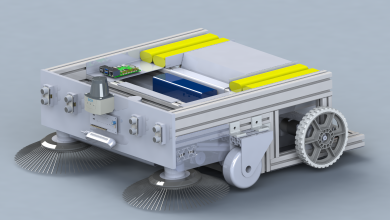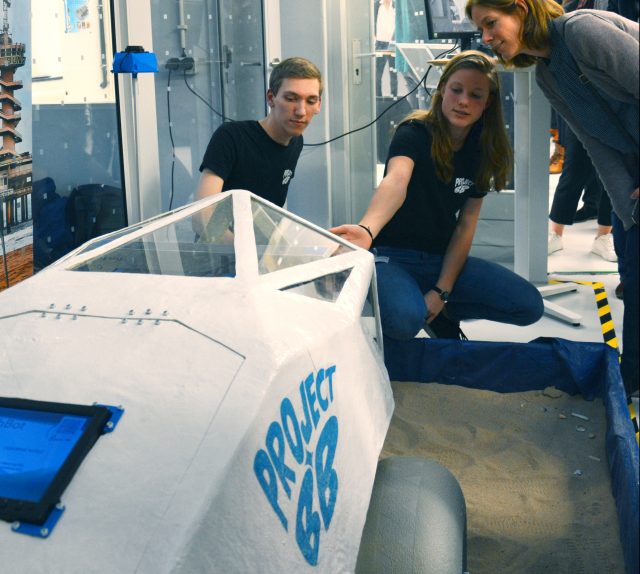The students follow an exciting programme that brings them into contact with all aspects of developing real robots. The students work in a multidisciplinary team to develop their own robot according to their own market and application research. During the programme, the student teams are based in RoboHouse.
Demo Day
On 24 January 2020, the results of the minor robotics were shown during the Demo Day in RoboHouse.
Following we present the projects that the students of the 2019-2020 minor developed.
Team 1 INStock
Stockbot
Supporting stock clerks by providing automated in store delivery of fresh produce.
In order to make the work hours from stock clerks more time efficient, AIRlab Delft gave Instock the challenge to create a robot that can bring crates filled with fruit and vegetables. The section where these are sold is in the very front of the store. While the stock room where they are stored is at the back of the store. By eliminating the need to constantly move products between these extremes, a lot of time can be saved which can be used to actually stock the shelves and help customers with questions. By accomplishing this, an even better shopping experience is created while profiting from less payed less time wasted. This project is commissioned by AIRLab Delft.
This project is commissioned by AIRLab Delft.
Team 2 Helix
Bottle filling robot
A robot that empowers dairy farmers
The innovative robotics company Lely, known for its autonomous milking robot, is continuously exploring new markets and products. Since three years ago, they are participating in the Robotics Minor of the TU Delft, to explore the possibilities of the future of robotics and their own products. This year they have challenged a group of students from different educational backgrounds (IDE, CSE, EE and ME) to work on one of their newest products, The Orbiter. The Orbiter is an on-farm factory that bottles, labels and stores milk bottles. This process is executed by a six degrees of freedom arm, that makes use of a designed gripper to move the bottles to different stations. In these stations a bottle is obtained out of a box, a label is applied, the screwcap is detached, the bottle is filled, the screwcap is re-attached, the bottle is sealed and finally, the bottle is set back. The process works fully autonomously and offers theoption to change bottle sizes and upscale. This project is commissioned by Lely.
This project is commissioned by Lely.
Team 3 BeachBotEngineers
Beachbot
Clean Beach please
Littering is a worldwide problem for which a solution needs to be sought. For our minor project, focus is put on beaches. ProjectBB aims to target the roots of the problem, those who cause the litter to be there in the first place, the people. Therefore, the goal is to not only build a robot that is capable of removing litter but is also capable of raising awareness regarding littering. Using the power of machine vision and convolutional neural networks, the robot is able to recognise litter. This enables the robot to selectively remove trash, leaving nature undisturbed. Furthermore, the robot has an interactive and reactive character, thereby encouraging beachgoers to help with cleaning up the beach. This is realised by means of a voice, display and attractive appearance. This project is commissioned by Project.BB.
This project is commissioned by Project.BB.
Team 4 Siduri Robotics
ACRA
Autonomous Cleaning Robotic Assistant
Operators in an industry environment spend a lot of time on cleaning. Siduri Robotics has created ACRA, short for Autonomous Cleaning Robotic Assistant, to help them in their tasks. By fully autonomously cleaning sections of the bottling line, an ACRA unit allows operators to better spend their time.
Capable of autonomously navigating using a Lidar and detecting waste using a depth camera, an ACRA unit can intelligently navigate through sections of the industry environment that need cleaning. A large array of ultrasonic sensors and mechanical switches ensure that the robot is safe, even when critical components fail. It’s adaptive cleaning mechanism is capable of handling a large variety of waste, from the smallest glass shards to an entire bottle.
Team 5 Simpulse
BedBasedEcho
Autonomous quick-look echoes
The BedBasedEcho is an automated system that can make echocardiograms, or assists an operator in the process. Ultrasound scans currently play a key role in the medical world. Doctors evaluate the condition of the heart using passive data such as blood pressure and the electronic signals of the heart. For a more accurate and reliable evaluation of the condition of a heart, cardiologists would like to obtain real-time data directly from the heart. Echocardiograms can provide the desired data, however with current techniques, obtaining an echocardiogram is very labour intensive and complex. The patient has to lie in uncomfortable and varying positions while the sonographer has to reach over the patient with the echo probe. Automation could relieve some of the complexity in the process of obtaining the echocardiogram. Automation would thus allow more patients to get an echocardiogram, which could lead to earlier diagnoses of possible heart conditions. Automated cardiac echo technology could also be implemented in third world countries, where there is a shortage of qualified doctors. This project is commissioned by Eelko Ronner.
This project is commissioned by Eelko Ronner.
Team 6 Aves Robotics
Wingspan
We got you koffered.
The process of loading and unloading luggage from a plane is a physically straining task, especially for planes like 737’s and Cityhoppers. These are smaller planes, so the cargo hull is not of appropriate size. Operators have to sit on their knees to load the luggage. There is already a solution that helps operators to reduce physical strain, which is the Powerstow. Even though this machine should provide help, most operators do not use it correctly. Therefore Wingspan is created. Wingspan will be the new end-effector of the Powerstow. Wingspan will autonomously load luggage in planes such as the 737’s and Cityhopper, using computer vision. During unloading, the Wingspan will assist the operator. The Wingspan has indication LEDs so that the operator can see what the robot is going to do. This project is commissioned by KLM apron services and Vanderlande.
This project is commissioned by KLM apron services and Vanderlande.
Team 7 ForeRS
Beetle
The golf training system
Golf driving ranges are not being used correctly: golfers don’t know what distance they are hitting and are bluntly hitting the ball without thinking too much about it. This is not training. Our driving golf target Beetle for on driving ranges will change this by giving the users the accurate distance from them to the target. It will also make use of training programs made by golf trainers to make sure golfers have an efficient and fun training experience. The outer shell of the driving target is made out of thick glassfiber reinforced polyester to withstand hits from golf balls even years down the line. The beetle will make use of machine vision to autonomously drive past obstacles and humans. It will also guide itself to its charging station autonomously. The batteries are designed to make the beetle last an entire day with ease. The target system has a rotating shaft so that the target will always face the golfer no matter where it is. The targets on top op the beetle are also interchangeable to give golfers all the options they need to ensure the most effective training. This project is commissioned by Burtley GTS.
This project is commissioned by Burtley GTS.
Team 8 Murarius
Construction Robot
A robot which can autonomously build a wall
See other robots that were made in RoboHouse
Back to overviewThe construction robot will autonomously build straight blind walls within an enclosed factory environment. These walls will then be transported to building sites where they can be installed by construction workers. This robot will be an answer to
the shortage of construction workers on top of being more cost-and time effective than human labour. The design shown below is the first prototype in a larger robotisation project of Xella. This project is commissioned by Xella.
This project is commissioned by Xella.
